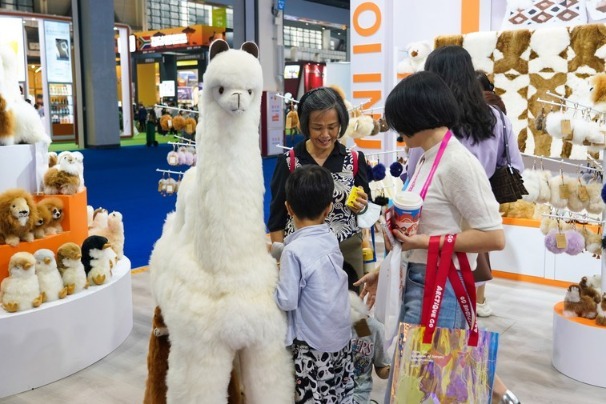Concerted efforts give child cancer patients new hope


Prompt diagnosis and treatment key to saving young lives
Born and raised in a small village in Xuzhou, Jiangsu province, Wang Meihua was diagnosed with late-stage nasopharyngeal carcinoma-a head and neck cancer-at age 14.
She was treated with chemotherapy and radiotherapy at a hospital for a year, before recovering and returning to school.
Since her university days, Wang has joined volunteer projects in an effort to help others.
The 27-year-old is now a full-time social worker at Shanghai Yanze Social Work Development Center, a private organization dedicated to helping children with difficult family backgrounds.
"I want to share my stories to show that children with cancer stand a good chance of recovering. We not only can grow up normally like our peers, but also repay society by spreading warmth and courage to others," Wang said.
According to doctors, pediatric tumors affect more than 30,000 minors all over China each year, and the number of cases is increasing. As children cannot express themselves clearly, such tumors are often quite large when discovered.
The doctors said most pediatric tumors form during embryonic development, while tumors reported in adults are mainly caused by an accumulation of genetic mutations in the body due to environmental stimuli.
Wang Huanmin, director of oncology surgery at Beijing Children's Hospital, said, "The biggest difference is that, in general, the cure rate for pediatric tumors is better than that for adult tumors.
"Due to the individuality of pediatric tumors, as well as the increase in early diagnosis and standardized treatment in recent years, the overall survival rate for patients with these tumors has reached more than 80 percent," he said.
Wang Meihua was initially confused when she felt movable soft tissue under the skin on her neck. She was taken to a village clinic, where doctors suggested she go to a higher-level hospital for checkups. The same advice was given when she visited a township clinic and a county hospital, before finally being recommended to a hospital in Xuzhou.
She said she was fortunate to be recommended the right hospital for swift diagnosis and proper treatment. Also, her family wanted to cooperate fully with doctors for Wang's treatment and recovery.
However, in many cases, children with tumors cannot be diagnosed promptly for various reasons, including parents' and doctors' negligence about such growth abnormalities.

Late discovery
Qin Bo, director of the widely acclaimed television documentary series focusing on the workings of Chinese hospitals, cited the example of a young patient from a rural area of Jiangyin city, Jiangsu, who had a bone tumor.
He said the parents of the 11-year-old girl are migrant workers in cities. The patient told her grandparents she was experiencing pain in her legs, but they said this was normal at the start of puberty.
Months later, the girl was taken to village- and county-level hospitals, but doctors did not find any problem. Her parents eventually returned home to take her to a hospital in Shanghai after she could no longer bear the pain.
Qin said, "Unfortunately, she had to finally undergo amputation, but doctors said if they had seen the patient six months earlier, they would have had more treatment options, rather than let her pay such a heavy price for saving her life."
At least 10,000 cases of bone cancer in child patients are reported in China annually, with experts saying many are at a late stage when discovered, due largely to a lack of attention from families and doctors.
Wang Jinhu, deputy director of oncology surgery at the Children's Hospital Affiliated with Zhejiang University School of Medicine in Hangzhou, the provincial capital, said, "Generally, pediatric tumors are rare, and some doctors in poorer regions may not hear of such a case during their entire careers, let alone encounter or treat such a patient.
"Therefore, our prioritized targets that need to be informed of pediatric tumors are frontline doctors, who will help parents obtain appropriate information about treatment and medication."
Li Zhizhong, secretary-general of the Shenzhen Shiyu Children Foundation and founder of Sunflower Children, an affiliated welfare project dedicated to child tumor patients, said scientific disease education is key to improving the level of diagnosis and treatment of pediatric tumors.
"We hope that through popularizing professional, reliable, timely and comprehensive scientific information, we can help end confusion and fear for every family experiencing such a plight," he said.
Dong Kuiran, director of oncology surgery at the Children's Hospital of Fudan University in Shanghai, said more patients with pediatric tumors are cured than adults with cancer.
"We don't use a five-year survival rate as a benchmark for children who have tumors-although this is the most common one for adult cancer. We set our sights much farther than five years for young patients," he said.
Li said that in past years, the foundation has collaborated with the China Anti-Cancer Association on compiling information about some types of cancer and related therapies and drugs. The two organizations have also won support from search engines for correct related information to be given priority when users search for it online.
Experts said many government agencies have jointly established programs to detect signs of tumors in early screening among children.
"The peak age for a pediatric tumor occurring is 3, but as children that young cannot express themselves clearly, an efficient and economical tool for extensive screening is needed," Wang said.

Novel therapies
The lack of effective drugs for young tumor patients, especially those with relapsed and refractory cancer, is another difficult problem.
Li said, "When experts treating tumors in adults gather to discuss whether it is excessive to have at least 100 research and development projects for PD-1 inhibitors-a potential cancer therapy-underway in China, we envy them greatly, as the number of such projects in the pediatric field is zero."
Experts said financial reasons are to blame for this, along with difficulty in recruiting child patients for clinical trials.
"We hope the government will create more momentum to drive research and development institutions and also companies to invest in this area so that innovation can be sustained," Li said.
For adults, finding an appropriate drug solution from existing medicines is another solution, Li said, adding that China has a larger patient community than other countries, and he hopes that more clinical trials can be promoted domestically to meet patients' needs.
Liu Yan, vice-president of Chinese biotech enterprise BeiGene, said that to date, the company has had one innovative therapy for neuroblastoma-cancer of immature nerve cells-approved in the China market. Another, for acute lymphoblastic leukemia, is awaiting approval.
"Before the therapy for neuroblastoma obtained market approval in China in August, 35 children had received it since the previous November in the Hainan Boao Lecheng International Medical Tourism Pilot Zone in Hainan province, as part of our efforts to improve drug accessibility as much as possible," she said.
The company said that improved affordability through various means, including collaboration with philanthropic institutions, is another key consideration.
Liu said, "We're also delighted to see that in past years many cities have introduced commercial supplementary medical insurance guided by their medical insurance authorities, and that innovative drugs to treat major diseases, including cancers, have been included on the reimbursement list."
Regarding a therapy to treat lymphoma in adults, she said the company and experts are considering the possibility of carrying out clinical trials for this on children.
Wang, the doctor from Hangzhou, said that in many cases the clinical values of a therapy are based on the number of patients.
"But I don't think such an appraisal works with drugs for children. When we save a child, we salvage an entire family's hopes for the future," he said.




